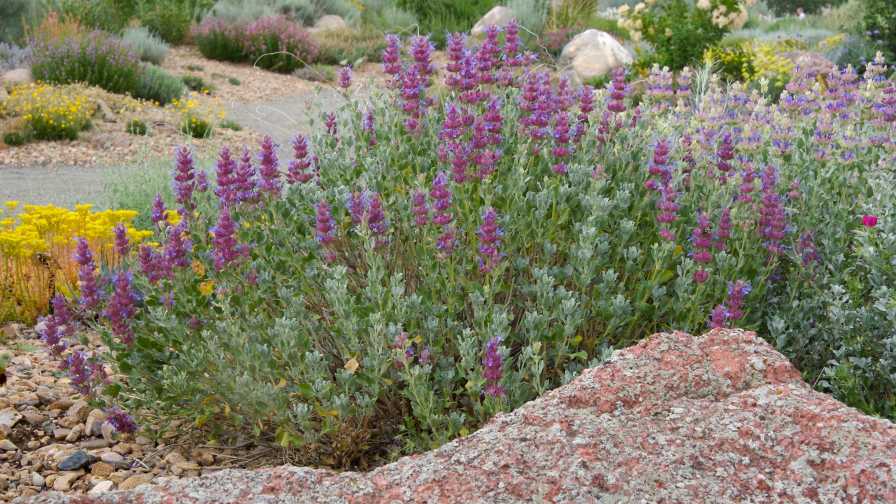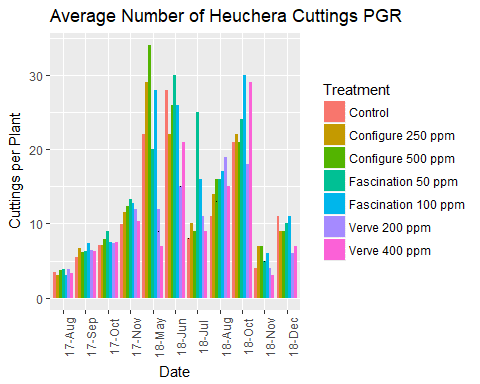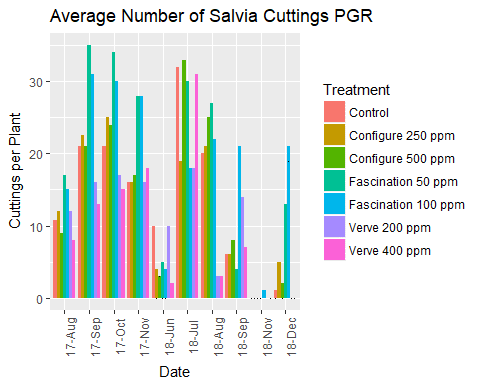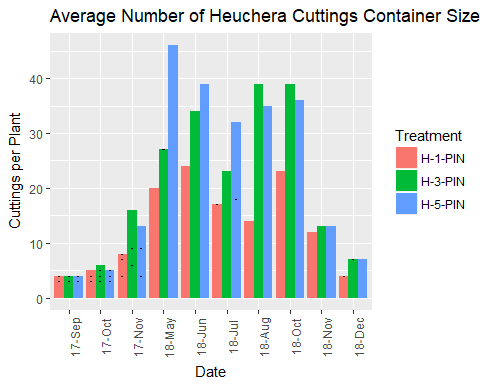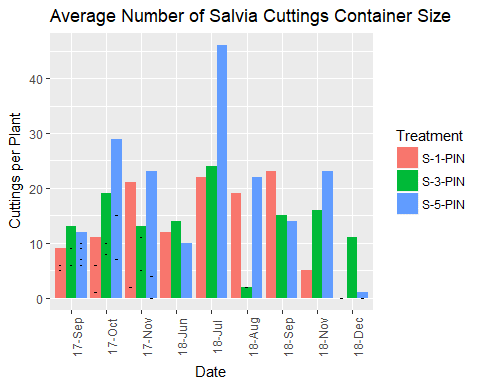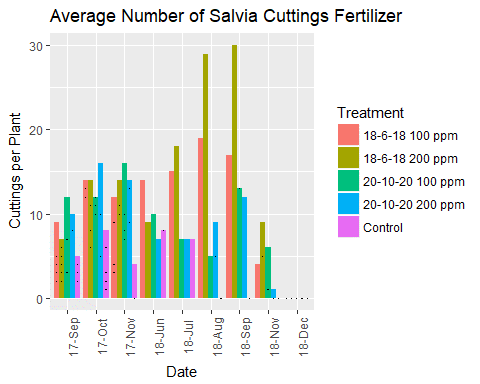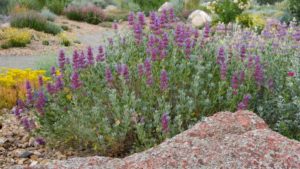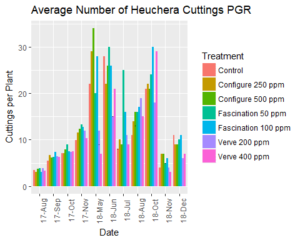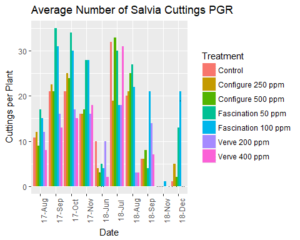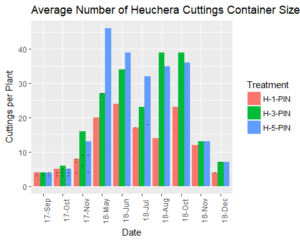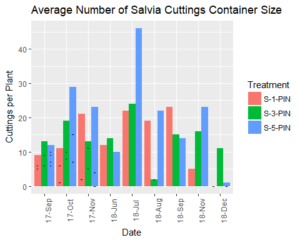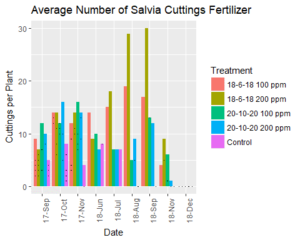How to Know When Your Perennial Cuttings Are No Longer Productive
How long can you keep herbaceous perennial stock plants and still be productive in producing cutting materials?
Colorado State University (CSU) has spent the last three years studying production methods for increasing efficiency and productivity with three difficult-to-produce herbaceous perennials. Working directly with growers from Colorado and neighboring states, CSU has developed effective protocols for Heuchera sanguinea ‘Snow Angel’, Zauschneria garrettii ‘Orange Carpet’, and Salvia pachyphylla ‘Mojave Sage’. These three taxa have been studied at the CSU Horticulture Center in Fort Collins, CO, with the goal of increasing stock plant production and propagation success. Looking at how applications of three different plant growth regulators (PGRs) at two rates, three fertilizers at two application rates, and four growing media grown in number -1, 3-, and 5-size containers have resulted in effective protocols for growers to use while producing these three perennials.
The question that follows once growers start to incorporate these improved protocols in their overall production program is, how long can a grower use the same stock plants and still see the increased production of vegetative material? The three studies (PGR, Media/Container Size, and Fertilizer) on the three perennials were extended out past the three months of the original experiment time period to provide an answer to this important question. Fifteen months later, we were able to see some trends that can help growers make smarter decisions with their stock plants.
Materials and Methods
Plant material of H. sanguinea, Z. garrettii, and S. pachyphylla was obtained as rooted plugs grown by Gulley Greenhouse (Fort Collins, CO) and were transplanted into number 1 black plastic containers for the PGR and fertilizer studies, and number 1, 3, and 5 black plastic containers for the media and container study. Three chemical plant growth regulators were applied at two different rates:
• Ethephon [250 and 500 mg·L–1 (ppm)] (Verve, Nufarm Americas, Inc.)
• 6-benzylaminopurine (200 and 400 mg·L –1) (Configure; Fine Agrochemicals Limited)
• Gibberellins A4A7 (GA) & N-(phenylmethyl)-1H-purine 6-amine (50 and 100 mg·L–1) (Fascination; Valent USA Corp.).
For the media and container study, plants were grown in four different media (Berger BM7, SunGro Metro Mix 360, SunGro Metro Mix 820, and Pindstrup peat substrate) in three different size containers. For the extended study, only the Pindstrup media and three size containers were examined, due to space constraints, since results from the original study indicated Pindstrup was the ideal media for these three perennials.
The three fertilizer products chosen for evaluation as part of the fertilizer study included Nature’s Source 3-1-1, Plant Marvel 18-6-18, and Grow More 20-10-20. Each fertilizer product was applied at two rates of nitrogen: 100 ppm and 200 ppm. For the extended study, Nature’s Source 3-1-1 was dropped due to poorer growth from this treatment in the original study.
The heuchera and salvia stock plants were evaluated once a month for plant height, width, and the number of cuttings harvested. Zauschneria had data collected every two weeks during the extended period of this study. After harvesting, the cuttings were weighed immediately before drying in an oven at 70°C for at least two days before measuring dry weights. Photographs were taken for visual comparisons of the treatment groups and control.
Results from PGR Study
The PGR study with Heuchera sanguinea resulted in no significant drop off, but also no real standouts from the different treatments. Fascination applied at 100 ppm resulted in more cuttings most of the later months in this study (Fig. 1 in slideshow above). PGR results for Salvia pachyphylla had a clear top performer in Fascination at either the 50 or 100 ppm rate applied (Fig. 2). This treatment was higher among all treatments generally and continually had more cuttings, while others dropped in numbers due to excessive woody growth or branching on the stock plants. Configure applied at 500 ppm on Zauschneria garrettii was best treatment for keeping increased quantity and quality of cuttings. The Fascination treatments had resulted in more cuttings, but were of poorer quality with spindly growth and not as desirable for propagators.
Container and Media Study
The media and container size study showed a constant trend throughout the duration of the study. Stock plants grown in number 3 or 5 size containers produced more cuttings per plant later in the year. This was seen in all three taxa. The H. sanguinea had higher numbers in both the number 3 and 5 containers (Fig. 3). S. pachyphylla had more cuttings from number 5 containers produced later in the study, but we observed drops in the numbers of all cuttings after 14 months. This may indicate that after this point, stock plants should be replaced (Fig. 4). Z. garrettii had more cuttings from plants grown in number 5 containers, but the numbers decreased after 12 months, which may indicate that after this point stock plants should be replaced.
Fertilizer Study
The fertilizer study did not result in the same trends as the other two studies. Heuchera indicated no clear trends and had an overall drop in the number of cuttings after 14 months. The 18-6-18 or 20-10-20 at both the 100 or 200 ppm rate appeared to have similar results throughout the duration of the study. With Salvia, the 18-6-18 produced the most cuttings later in the study. However, no cuttings were taken over the last two months of the study due to the excessive woody growth on all S. pachyphylla stock plants (Fig. 5). Zauschneria showed no distinct trends over the 13-month period, but seemed to drop off after that period. This could indicate that after 13 months, it would be a good time to replace Z. garrettii stock plants.
Conclusion
Growers using the improved protocols for stock plant management with these three herbaceous perennial taxa can keep their stock plants for over a year in some cases and still have a steady number of cuttings produced. Number 5 containers are suggested if the grower is planning to keep the stock plants for longer than a one-year time period. Applying PGR for increased cutting yields is one recommendation. Applying Fascination on Salvia and Heuchera has shown that increases in cutting numbers can last over 14 months. The use of Configure 500 ppm on Zauschneria also can result in increased quality cutting material on stock plants over a 14-month period.
The take-home message from this stock plant longevity study is that growers can keep greenhouse stock plants longer by using a larger container and applying specific PGR at a certain rate on various herbaceous perennial taxa.



